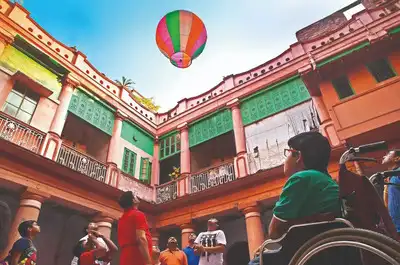ARTICLE AD BOX

This World Photography Day,we re-imagine our city as fans of the American auteur, whose cinematic language is deeply inspired by Satyajit Ray
When Australian author and travel writer Julietta Jameson recently visited Kolkata, she described the feeling as “stepping into a Wes Anderson film”. “It’s as if I’ve stepped into the auteur’s viewfinder, so vibrant, quirky and decidedly decaying are my surroundings,” she wrote about the city in a Sydney Morning Herald article.
Few cities lean so naturally into Anderson’s grammar of symmetry, colour, nostalgia, and quirk. Walk down Chowringhee or slip into a Bowbazar bylane and you’ll find it – walls peeling in pastels, facades frozen in time, characters who could step straight into a storyboard. For World Photography Day, we turned to those who live and work with Kolkata’s heritage, and its film and visual culture to ask: where do they see Anderson’s cinematic language hiding in plain sight?On my first visit to Kolkata, I check in at a hotel near the Alipore Zoological Garden… its entrance, a dinky stone arch with cement animals roaming across it and identical toy-like clocktowers either side, delights that part of me that loves Anderson’s work. In fact, it seems to me everything is ‘accidentally Wes Anderson’ – Julietta Jameson, journalist and writer‘Kolkata is full of Wes Anderson frames’

The Grand hotel in Kolkata from a time when street vendors hadn’t blocked the view

The Grand hotel in Kolkata from a time when street vendors hadn’t blocked the view
The City as a film set“Every time I look at Kolkata, I can’t help but think how perfectly it could fit into a Wes Anderson frame,” says GM Kapur, State Convener, INTACH (Indian National Trust for Art and Cultural Heritage).
“The symmetry of the Writer’s Building, the nostalgia-filled corridors of Lalbazar, and the timeless charm of the Oberoi Grand all carry that cinematic balance. Even Park Mansions and Esplanade Mansions, with their Art Nouveau flair, tell stories of another era.
Standing at Park Circus’s seven-point crossing or remembering the grand vista of Chowringhee before the flyover, I see the city’s old-world elegance trying to shine through again,” he said.

Symmetry, colour and quirk Symmetry, colour, and quirk For Mudar Patherya, heritage activist and restorer, Kolkata reveals itself not in sweeping vistas but in its intimate corners. “From Bowbazar’s red facades set against yellow taxis to bylanes where the afternoon sun transforms peeling walls into glowing canvases, the city is pure cinema. Standard Assurance, with its domes painted in red, yellow, and white, is Kolkata’s own Wes Anderson frame – it has a personality.
I’ve taken over a lakh photographs of the city’s bylanes, because that’s where Kolkata truly lives. Unlike European towns where beauty is immediate, Kolkata demands patience. You have to go close, walk its lanes, and let the extraordinary hide inside the ordinary.”

Wes Anderson’s styleSymmetry: Every frame balanced like architectureColour palette: Vibrant yet curated, often yellows, reds, and pastelsPatterns & details: Checks, repetition, and meticulous geometryQuirk: Characters, uniforms, signages, or small objects with personalityThe ordinary made extraordinary: Turning bylanes, clubs, or even a taxi reflection into cinematic magic

Kolkata on a Wes Anderson storyboardFor Aradhana Seth, production designer and artist, who worked as art director & set decorator in Wes Anderson’s The Darjeeling Limited, the city reveals itself in whimsical fragments rather than grand monuments.
“When I imagine Kolkata through Wes’s frame, my mind immediately goes to the football fields and cricket grounds around the Maidan – the small, modest clubhouses, the old stands, even the racecourse. They carry a particular architectural character as does the Birla Planetarium that could easily slip into his cinematic universe.
” Seth notes that Anderson’s signature lies in colour, symmetry, detail, quirk, and surprise – a way of making “the extraordinary even more extraordinary, and the ordinary suddenly feel extraordinary.” In Kolkata, she sees that spirit in the repetition of clay idols at Kumartuli, hand-painted signages, the graphic geometry of Howrah Station, even in the whimsical strangeness of racecourse number boards or a dolls’ museum. “Kolkata is full of pockets that could transform into Wes Anderson frames – you just need to look through his lens and eye, depending on the script.”

According to production designer Aradhana Seth, ‘the graphic geometry’ of Howrah Station makes it a perfect fit for a Wes Anderson film
"Get the latest updates on Times of India, including reviews of the movie Coolie and War 2."



.png)
.png)
.png)
















 8 hours ago
2
8 hours ago
2









 English (US) ·
English (US) ·